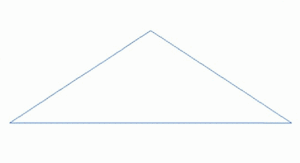What Are Fractals?
What Are Fractals?
Fractals
If you try to measure something irregular, like the coastline along a creek, you will find that the shorter the measuring unit you use, a one-foot long stick instead of a three-foot-long yardstick, for example, the longer the thing will be, infinitely. Normally, in geometry, you measure something that is curved by setting a straight line against the curve and using more and more straight lines around the curve until you can approximate the length of the curve. With something that is shaped irregularly, though, this doesn’t work.
This is the problem Benôit Mandelbrot set for himself when he asked himself, as a young researcher, “How long is the coast of Great Britain?” He decided you needed to make different assumptions from those normally used for measuring curves. And, he decided that, ultimately, you couldn’t measure something that had such irregular edges. What you could do was develop a system for measuring the complexity of the edges of an object within a defined area, and that’s what he did. He defined his approach in a paper in 1967, titled with the original problem, “How Long Is the Coast of Great Britain?” He named these geometric objects fractals in 1975.
Fractals have the properties that:
- Their edges are approximately smaller replicas of the whole shape
- Their edges are so detailed that the normal curve measuring tools don’t work
- Their length is undefinable.
Mandelbrot’s definition of fractals was that they were “a rough or fragmented geometric shape that can be split into parts, each of which is (at least approximately) a reduced size copy of the whole” changing detail without changing scale, they are nowhere differentiable, that is, you cannot measure the length.
Mandelbrot also said fractals are common in nature and extended his definition to include objects with very regular, but complex edges. Imagine trying to measure all the way around all the leaves on all the branches on a tree. A branch of a tree has a similar shape to the whole tree. The branching pattern of a leaf is similar to the branches on the tree. You can measure the height and width of a tree, but, no matter how small your measuring tool, you can only approximate the length around all the branches and leaves.
How would you measure the length of all the creeks that lead into a single river? The head of a river, where the creeks feed in, has approximately the same shape as the branches that feed into the final river.
Spirals are considered fractals because they are a repeating pattern. They simply expand in a regular way.
Let’s see how many fractals we can find on a walk outdoors.
Materials:
- Paper
- Pencil, pen or crayons
- Nature
- Walking shoes
Instructions:
- Look for things outdoors that have complicated edges and the smaller version of them is similar in shape to the whole
- Make a list or draw as many as you can find in 10 minutes
- You can either make your own list, separate from an older grandchild, or help a younger grandchild make their list.
What Should Happen?
Examples of fractals in nature include:
- Snail shells (spiral)
- Sunflowers (spiral)
- Tree bark if it folds and expands as it ages
- Broken pieces of wood as they break into smaller pieces
- Ferns
- Queen Anne’s Lace
- The cracks in dried mud
- Rocks, boulders and pebbles
- Lightning
- Broccoli
- Pineapple
- Peacock tail
- Clouds
- Snowflake (you’ll have to save this one until winter)
- Frost crystals (do you have a refrigerator that has to be defrosted?)
- Moutain ranges
- Stalagmites and stalagtites
Why Is This Useful?
Understanding that rough edges cannot be measured precisely, but that patterns repeat in smaller versions of the whole has led to a number of applictions of fractal geometry.
Computer graphics use fractals to repeat patterns instead of having to hand-draw each one. In 1978, Loren Carpenter, who was with Pixar Animation by the time he was interviewed for a PBS Special on fractals in 2008, introduced fractals into computer graphics by writing a program to draw a mountain for a Boeing publicity shot by drawing a triangle for a mountain, then letting the computer draw smaller and smaller triangles to create the detail of the mountain. Later, Carpenter joined Lucasfilm and created a whole planet for Star Trek II: The Wrath of Khan.
Astronomer Nathan Cohen, in the 1990s, after hearing a lecture on fractals from Mandelbrot, decided to test whether bending an antenna in a repeating fractal shape could improve reception. It not only reduced the noise on the line, it allowed him to receive more frequencies in the same sized space used by the original antenna.
In 2008, biologists James Brown and Brian Enquist and physicist Geoffrey West were in the process of testing how much carbon dioxide a single leaf could absorb and using fractal geometry to calculate how much an entire tree or forest could absorb.
Thanks to the fractalfoundation.org for this idea of a scavenger hunt.
And, thanks to webecoist.momtastic.com for more examples of fractals in nature.
Carol Covin, Granny-Guru
Author, “Who Gets to Name Grandma? The Wisdom of Mothers and Grandmothers”
http://newgrandmas.com
Filed in: arts & crafts & educational • education • Playtime




If I'm bored as a pensioner I may – or may not – do this exercise, Cheryl:-)
The fun part about being a pensioner is there is time to explore things you never could get to when you were working full-time, though it may be more fun just to read about than to do.
Wow, Cheryl you have no fear. Fractals? Way to go for taking complex and making it comprehensible. 🙂
You sure are going to teach your grandchild some interesting things Cheryl.
I'm definitely learning a lot about math concepts from these posts! When can we expect some language activities?
Well Jeri as our resident English expert all you have to do is give the word and you will be the language activity contributor for this blog. 🙂
Great suggestion, Jeri. I know there are some interesting semantic concepts, like homonyms, homophones and antonyms, but never thought about turning them into an activity. How about polyseme, graded antonym and hyponym, to say nothing of my favorite, taxonomy
I would love to have you lead me and anyone else who wants to come on a nature fractal hike. Sounds fun!
I think of fractals as a place where art meets science. Or math. Or all of the above.